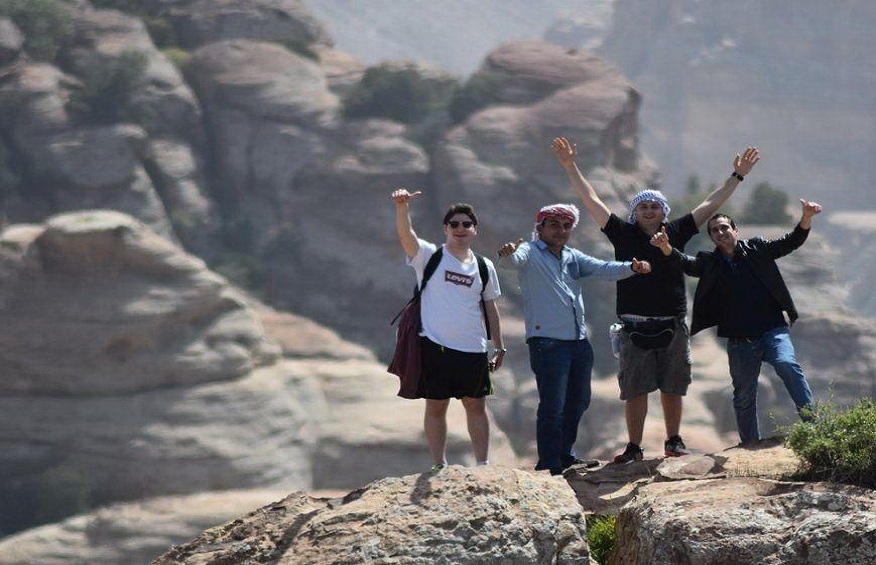The most beautiful reserves in Jordan
Between its valleys, mountains, oases, gorges, its arid and desert landscapes, Jordan has an exceptional biodiversity where many wild animals live. Discover our selection of the most beautiful nature reserves in Jordan to hike through impressive landscapes and meet endemic, rare and protected animal species.
1. Dana Nature Reserve
Located in south-central Jordan, the Dana Nature Reserve is the largest forest reserve in the country. A true natural jewel of Jordan, the reserve offers a multitude of landscapes: canyons, gorges, wadis, arid plains, geological formations, mountains and colored cliffs…With so much diversity, the nature reserve is home to many wild animals. There are mammals such as the Nubian ibex, the Syriac canary, the striped hyena, the sand cat, the desert lynx or the mountain gazelles. It is also a paradise for bird watchers. Some hiking trails allow bird watching such as Campsite Trail. In particular, you will be able to see many birds of prey (eagles, buzzards, falcons, etc.) as well as rarer species such as the Syriac canary.
In addition to hiking and wildlife observation, the Dana nature reserve is also an opportunity to enjoy a religious immersion by crossing some picturesque villages in which you can meet and share the daily life of the Bedouins.
2. Mujib Valley Nature Reserve
Nestled in the foothills east of the Dead Sea, Mujib Valley Nature Reserve is one of Jordan’s finest reserves. Located in the gorges of Wadi Mujib whose depths reach 410 meters below sea level, it is the lowest reserve on the planet.This is the perfect place for thrill seekers! And for good reason, you can do many trails, aquatic hikes, climbing and climbing, canyoning or rafting.
Consisting mainly of desert landscapes, the Mujib Valley has rivers and magnificent waterfalls. The presence of water has given this hostile environment an exceptional biodiversity. There are nearly 250 species of carnivorous mammals (oryx, desert cats, Syrian wolves, caracals, Nubian ibexes, rustic goats, etc.), 386 species of resident and migratory birds, several reptiles and freshwater fish. On the plant side, more than 400 varieties of plants grow in the reserve including sublime orchids, acacias, tamarixes with pink flowers, neriums, phoenixes and much more…Please note: it is not possible to hike freely in the Mujib Valley Nature Reserve. It must be visited in the company of a guide.
3. Ajlun Forest Reserve
Direction the northwest of the country, about forty kilometers from Amman, to discover the historic city of Ajlun and its forest reserve.Renowned for its medieval fortress perched on Mount Jabal’Auf, the city of Ajlun is an essential stopover on any trip to Jordan. Completed in 1185, the fortress of Ajlun is considered a jewel of Arab-Islamic architecture of the Middle Ages. As for the forest reserve of Ajlun , you will find many hiking trails crisscrossing the forests of pines, oaks, carob trees and pistachio trees. The opportunity to come across some wild animals such as jackals, wild boars, striped hyenas, gray wolves, deer or the rare crowned porcupine.
In addition to visiting the fortress and hiking in the forest reserve of Ajlun, do not miss the visit of the great mosque of Ajlun, as well as Tell Mar Elias, the famous place where the prophet Elijah was born.
4. Azraq Wetland Reserve
Azraq is a town located in the middle of the semi-arid Jordanian desert in the center-east of the country. It is an oasis comprising pools, a marshy area and a huge mudflat. The city is particularly known for its castle of Azraq (or Qasr Azraq) whose visit is worth the detour. The wetland was originally created 250,000 years ago by aquifers resulting from geological changes. Unfortunately, it is now only 10% of its original size due to ecological damage resulting from the intensive pumping of fossil water. To preserve the place, the Royal Society for the Conservation of Nature made the area a protected wetland reserve in 1978. Although far fewer in number than before, the Azraq Wetland Reserve still remains a superb site for bird watching with 300 species of migratory birds.
During a hike or bike ride, you can see Jordan’s national bird, the Sinai finch, but also desert sirlis, Cetti’s warbler, desert bullfinches, marshes, fighting knights, avocets, small plovers or even sandpipers…The Azraq reserve also has other animal species (jackals, foxes, striped hyenas, wolves, lynx…) as well as plant species such as aquatic plants (allies, reeds, sea buckthorn, local aromatic tamarisk…).
5. Shaumari Wildlife Sanctuary
After visiting the Azraq wetland reserve, continue your journey about ten kilometers away to discover the Shaumari wildlife reserve, a breeding and breeding center for endangered wild species.Covering an area of 21 km, the reserve is divided into two areas: a semi-desert area crossed by a stream and a stony desert covered with a layer of black flint.
Among the wild animals that can be observed there are Arabian oryx, desert gazelles, Persian onagers, Houbara bustards and Somali ostriches. The Arabian oryx is the star of the scene. Formerly almost extinct, today there are about 200 in the reserve. You can easily see them during a safari!


